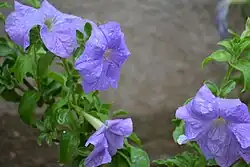Petunia integrifolia
| Petunia integrifolia | |
|---|---|

| |
| Scientific classification | |
| Kingdom: | Plantae |
| Clade: | Tracheophytes |
| Clade: | Angiosperms |
| Clade: | Eudicots |
| Clade: | Asterids |
| Order: | Solanales |
| Family: | Solanaceae |
| Genus: | Petunia |
| Species: | P. integrifolia
|
| Binomial name | |
| Petunia integrifolia | |
| Synonyms[2] | |
| |
Petunia integrifolia (syn. Petunia violacea), the violet petunia[3] or violetflower petunia,[4] is a species of wild petunia with violet-colored blooms.[5][6] Petunia integrifolia is native to Brazil, Argentina, Paraguay and Uruguay.[7]
P. integrifolia bears flowers approximately 1.5 inch in diameter and the plant is typically smaller and harder to cultivate than the well-known hybrid bedding Petunia now known correctly as Petunia × atkinsiana.[8][9]
Taxonomy
The species was first described as Salpiglossis integrifolia by William Jackson Hooker in 1831.[10] It was transferred to the genus Petunia as P. integrifolia by Hans Schinz and Albert Thellung in 1915.[11] Petunia inflata had sometimes been considered to be a subspecies of P. integrifolia, but the two have different native ranges, with P. inflata growing in more northern areas.[12]
Hallucinogen
Petunia violacea Lindl. has been reported to be used as a hallucinogen in Ecuador, where the plant has the vernacular name shanín. The drug is said to cause sensations of levitation and flight – a type of hallucination often associated with the use of the antimuscarinic drugs such as the Atropa belladonna based flying ointments of Medieval and Early Modern Europe.[13] [14]
References
- ^ Nowick, Elaine (1 October 2014). Historical Common Names of Great Plains Plants, Volume I: Common Names. Lincoln, NE: Lulu.com. p. 437. ISBN 978-1-60962-058-5.
- ^ "Tropicos.org". Retrieved 13 September 2015.
- ^ Nowick, Elaine (1 October 2014). Historical Common Names of Great Plains Plants, Volume I: Common Names. Lincoln, NE: Lulu.com. p. 437. ISBN 978-1-60962-058-5.
- ^ NRCS. "Petunia integrifolia". PLANTS Database. United States Department of Agriculture (USDA). Retrieved 23 September 2015.
- ^ ITIS on-line database (1996). "Petunia integrifolia". U.S. Geological Survey. Integrated Taxonomic Information System. Retrieved 12 September 2015.
- ^ Michelle Wishhart. "Petunia Violacea plants". Home Guides | SF Gate. Demand Media. Retrieved 12 September 2015.
- ^ https://www.worldfloraonline.org/taxon/wfo-0001024437;jsessionid=2902B8AC765F4835889FE20D1B3EE0C6
- ^ Quentin Groom (2011). "Petunia integrifolia". Retrieved 12 September 2015.
- ^ "Petunia (group)". Missouri Botanical Garden. Retrieved 12 September 2015.
- ^ William Jackson Hooker (1831), "Plate 3113 and two pages of descriptive text", Curtis's botanical magazine, vol. 5 (new series) = volume 58
- ^ Hans Schinz (1915), "Petunia integrifolia in Mitteilungen aus dem botanischen Museum der Universität Zürich (LXXI.)", Vierteljahrsschrift der Naturforschenden Gesellschaft in Zürich, vol. 60, p. 361
- ^ Ando, T.; Ishikawa, N.; Watanabe, H.; Kokubun, H.; Yanagisawa, Y.; Hashimoto, G.; Marchesi, E.; Suárez, E. (2005), "A Morphological Study of the Petunia integrifolia Complex (Solanaceae)", Annals of Botany, 96 (5): 887–900, doi:10.1093/aob/mci241, PMC 4247055, PMID 16103037
- ^ Schultes, Richard Evans Hallucinogenic Plants a Golden Guide, pub. Golden Press N.Y., 1976, Library of Congress Catalog Card Number : 74-21666, page 150.
- ^ Haro, A., S. L. : "Shamanismo y farmacopea en el Reino de Quito". Inst. Ecuat. Cienc. Nat. Contr., No. 75 : Nov. 1971.
External links
 Data related to Petunia integrifolia at Wikispecies
Data related to Petunia integrifolia at Wikispecies Media related to Petunia integrifolia at Wikimedia Commons
Media related to Petunia integrifolia at Wikimedia Commons- P. integrifolia's entry at Gardenguides.com